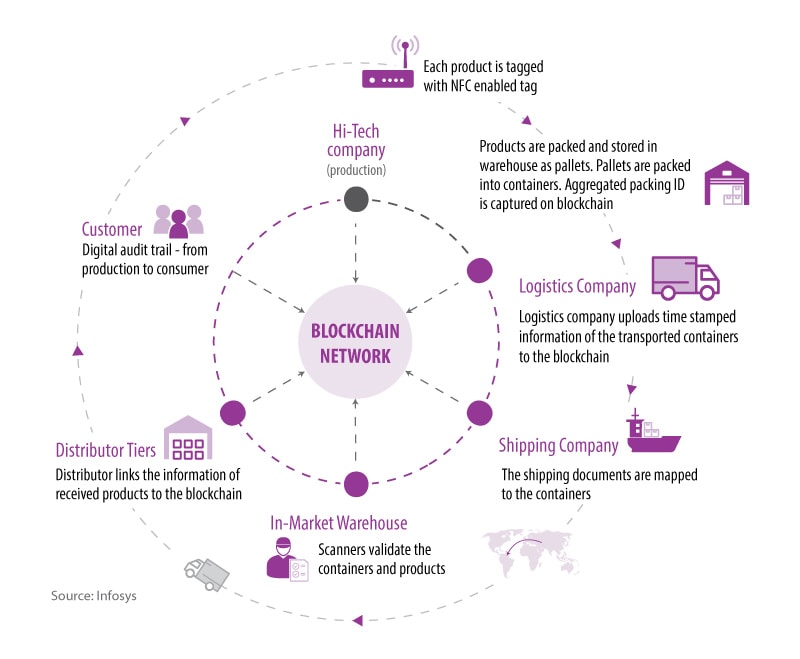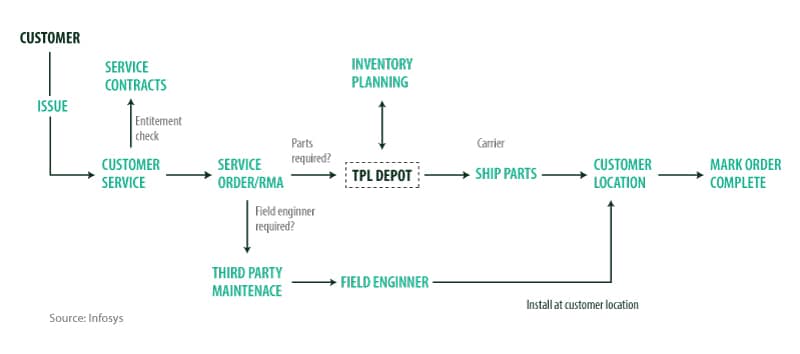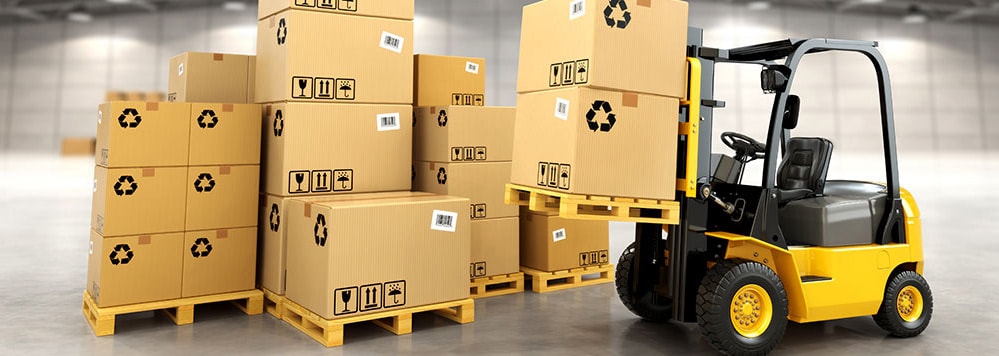In this interview for the Infosys Knowledge Institute, Srikanth Challa, senior director at Infosys, discusses the opportunities that blockchain presents for high-tech industries, the challenges involved and how enterprises can unlock the potential of blockchain.

IKI: What are the current challenges facing high-tech companies that the use of blockchain could solve?
Srikanth: Blockchain solutions can address areas where there are many stakeholders interacting in a complex network and require a single source of information. Some of the most relevant areas where blockchain can help high tech enterprises are in supply chains, reconciliation and after sales services.
Supply chain
A typical high-tech enterprise works with multiple vendors and distributors, and they, in turn, work with many entities, such as resellers and downstream partners. The tech enterprise generally works with a third party logistics company that moves products from factories to warehouses. The products are then moved from the warehouse — say in Taiwan — and shipped to the market — say in the U.S. — and stored in warehouses close to the market. Products are then taken by resellers who, in turn, sell them to retailers or enterprises. There are different modes and channels of supply involved.
Some product units might be reported as damaged, go missing during the transit or have to be returned. Today there is no real time, end to end visibility for all the parties involved. There can be an information mismatch between what the distributor sees as inventory and what the tech company sees as inventory, which can lead to confusion. Multiple sources of information can lead to incorrect forecasting, budgeting and costing.
Blockchain can help solve this issue by providing a single source of information to all the entities involved. When the goods are produced, their information could be stored on blockchain. As soon as a shipment is ready to go out, a transaction could be triggered on blockchain creating an entry with information such as source, destination, shipping time, etc. The process could also be automated with smart contracts such that a bill of lading is created when the shipment is ready, and an invoice is generated as soon as delivery is made.
Blockchain facilitates transparency by preventing information silos and providing real-time access to available data
All the companies across the blockchain network have real-time access to this information, including the customer, enabling easy traceability. Thus use of blockchain could help remove information silos and help build trust by facilitating transparency across the network (Figure 1).
Reconciliation
Reconciliation is always tedious for all the parties involved in complex transactions since they all have different proofs of delivery and invoices. Discrepancies in shipping and claims forms can put the reconciliation on hold, delaying receivables. If all the information is available on blockchain, it can be a trusted source of evidence that could allow faster reconciliation. Going one step further, smart contracts can help automate the creation of billing documents and invoices, which can reduce the hassles involved in the process.
After-sales services
High-tech companies have different service agreements with different enterprises for different products. Consider an instance where an employee of a buying organization finds some problem with the product. The employee calls the tech company’s customer service, but might not know what kind of service agreement his company has with the tech company. While product information might be on the tech company’s system, the consumer details might be on the reseller’s system, and the service level agreement details might be on yet another system. Collating all this information from different sources is tedious and delays response time. It is a harrowing experience for the customer and could hurt the tech company’s reputation.
This story does not end here. Say the details are finally found and a request for a replacement part or unit is registered. The tech company has to order the replacement from its warehouse, which may be in a different city or country. The replacement then has to be shipped to the customer’s location. The tech company has to block time for an engineer to visit the customer based on when the replacement is scheduled to arrive (Figure 2). Suppose there is any delay in shipment and this information does not immediately reach the field engineer. The engineer might reach the customer location before the replacement does. This results in increased cost and bad customer experiences.
Figure 1: Designing a blockchain network for a supply chain

A blockchain containing all the product, sales and customer details can provide a complete snapshot of the buyer, location, service-level agreement and warranty period within seconds. Also, with all the inventory information available in one place, the customer service executive can see the quantity of the replacement components available, the nearest location where they are available, the time needed for shipping and the time needed for delivery. A field engineer can then be assigned to the repair job. Relying on real-time transit information, the engineer can reach the customer location at the same time as the needed part. This would greatly improve both the customer experience and the service executive’s productivity.
IKI: Who would be the participants of the blockchain network and how would it be built?
Srikanth: The process has to start with a business problem. A company might have difficulties in tracking goods, vendor management or inventory forecasting. If there are many stakeholders involved in the value chain and there is a need for transparency and single source of information, blockchain could be valuable.
But a single company cannot set up an elaborate blockchain network. For example, consider a high-tech company that has supply-chain related issues and decides to implement a blockchain-based solution. It will have to bring the logistics company, distributors, resellers and retailers on to the blockchain network. These businesses would be ready to invest in this network only if they see an advantage for them. It is also important to define the roles of all the participants in the network and establish a governance framework.
From a technology point of view, the type of blockchain framework – Hyperledger, Ethereum or others – has to be decided. As the frameworks are still evolving, there are no standard guidelines on which blockchain framework would be most suitable for a particular use case, although such guidelines might be developed in the future. For now, the selection of a framework would depend on use cases and the availability of skills.
Figure 2: Processing an after-sales service request

Setting up a blockchain network also requires collaboration with the cloud infrastructure providers that create the infrastructure foundation for blockchain.
It is very important to have an integrator who has a technical knowledge of blockchain framework, the underlying infrastructure and an understanding of the entire value chain of the industry, not just the business process in question. This is important to building a scalable blockchain network.
An integrator adept with the technical know-how of blockchain framework is critical to building a scalable blockchain network
IKI: Is blockchain ready for business today? What limitations do you see?
Srikanth: The biggest challenge that blockchain developers are trying to address is interoperability. Today transactions within the network are working perfectly. But for blockchain-based solutions to be scalable, different blockchains should be able to interact with each other seamlessly. For example, when a product is manufactured, the data might be stored on one blockchain. After sale, it might move to another blockchain. Not all the stakeholders will be a part of all blockchains, so it is critical to explore how to make blockchains talk to each other. With evolving technology and frameworks, developers are trying to see how this can be standardized.
Another challenge is establishing a governance framework Decentralization is the underlying idea of blockchain. Therefore, authority cannot reside with only one participant in the network. Answers to questions about the governance framework and how to ensure equitable distribution of power become essential. The greater the number of participants, the more useful the blockchain. But if companies have to invest to be a part of blockchain, they would like their roles to be clearly defined.
IKI: What are the key factors for developing and implementing a scalable blockchain solution?
Srikanth: The most important factor is getting a buy-in from all the stakeholders within the company and from the collaborators. Governance and interoperability are also crucial in building a robust network. Security and privacy concerns have to be addressed to ensure a reliable system.
Buy-in from all stakeholders
Blockchain projects are long term and demand a lot of investment. Therefore, it is necessary to get buy in from the company’s leadership when starting the projects. Creating a scalable blockchain also requires participation and investment from many participants in the network. No one would be keen to participate unless they can expect to see a return on their investment. The benefits might not be the same for all companies involved. For the high-tech company it might be the ability to cut cost and sell at a higher margin. For the logistics company, the advantage could be faster reconciliation time. Each party’s benefit would have to be brought to the table.
Different companies might have their own blockchain consortiums. A logistics company might have to be on scores of blockchain consortiums based on its clients. Being part of more blockchain networks means more cost, so there has to be a strong incentive for companies to join your blockchain consortium.
Security and privacy
In blockchain, multiple copies of data are distributed through the network. Also, once the data is logged on to the network it is immutable. This means data will reside on the blockchain forever. This naturally raises more concerns about privacy and security. Not all companies in the blockchain consortium would want their data to be shared with all the other participants in the network. Therefore, the system has to be designed in such a way that only certain information is shared.
Blockchain developers are exploring ways to model data to share information without disclosing the underlying attributes. For example, the reseller will get to know when the goods will arrive at his warehouse. But he will not see the name of the delivery person and the route he is taking, though the information will be present on blockchain. This can be done through a protocol called zero-knowledge proof. Role-based access and authorizations have to be defined for all enterprises with blockchain access.
Blockchain guarantees that the data cannot be tampered with. But it cannot guarantee that incorrect data does not enter blockchain if the approving nodes are not carefully designed.
Designing the consortium
Building secure, resilient blockchains requires meticulous planning. Every participant should have a definitive role in the blockchain network. All the participants, along with IT and business teams, should be aligned to clearly defined business goals from the early stages. The distributed ledger technology, underlying infrastructure, and nodes should be designed to meet these goals.
Blockchain cannot transform businesses overnight. The companies have to start with a few services that can benefit from blockchain and then slowly add more. At the same time, they need to design a framework that will be able to accommodate different kinds of services in the future.





